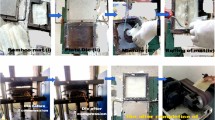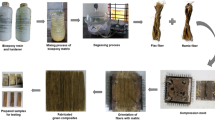Abstract
In this study, sisal and coir fiber-based epoxy composites were fabricated using compression molding route. Optimization technique using Taguchi and grey relational analysis (GRA) was employed to find the best condition for tensile, flexural and impact properties. Sisal (0–20 wt%), coir fibers (0–20 wt%), NaOH treatment (0–8 wt%), compression pressure (10–16 MPa) and temperature (100–120 °C) are the different factors with various levels. Multi-response optimization using GRA showed significance of both the fibers in enhancing mechanical properties. The response table of GRA concluded that combination of sisal 20%/coir 15%/NaOH treatment 5%/compression pressure 10 MPa and temperature 120 °C has the best mechanical results. SEM images indicated the advancement in adhesion of reinforcement and epoxy resin by hybridization of fibers. The artificial neural network (ANN) prediction states predicted and experimental values for various trials are almost same, and regression graph showed a straight line with R-value 97.321%. These fabricated composites can be used in aerospace and automobile industries for their interior parts.












Similar content being viewed by others
References
Sumesh KR, Kanthavel K (2019) Synergy of fiber content, Al2O3 nanopowder, NaOH treatment and compression pressure on free vibration and damping behavior of natural hybrid-based epoxy composites. Polym Bull. https://doi.org/10.1007/s00289-019-02823-x
Sumesh KR, Kanthavel K (2019) Green synthesis of aluminium oxide nanoparticles and its applications in mechanical and thermal stability of hybrid natural composites. J Polym Environ. https://doi.org/10.1007/s10924-019-01506-y
Sumesh KR, Kanthavel K, Ajithram A, Nandhini P (2019) Bioalumina nano powder extraction and its applications for sisal, coir and banana hybrid fiber composites : mechanical and thermal properties. J Polym Environ. https://doi.org/10.1007/s10924-019-01496-x
Li S, Ball B, Donner E et al (2018) Mechanical properties of green canola meal composites and reinforcement with cellulose fibers. Polym Bull 76:1257–1275. https://doi.org/10.1007/s00289-018-2439-2
Sheykh MJ, Tarmian A, Doosthoseini K (2017) Wear resistance and friction coefficient of nano-SiO2 and ash-filled HDPE/lignocellulosic fiber composites. Polym Bull 74:4537–4547. https://doi.org/10.1007/s00289-017-1975-5
Sumesh KR, Kanthavel K, Vivek S (2019) Mechanical/thermal/vibrational properties of sisal, banana and coir hybrid natural composites by the addition of bio synthesized aluminium oxide nano powder. Mater Res Exp 6:1–29. https://doi.org/10.1088/2053-1591/aaff1a
Rahman R, Hamdan S, Jayamani E et al (2018) Tert-butyl catechol/alkaline-treated kenaf/jute polyethylene hybrid composites: impact on physico-mechanical, thermal and morphological properties. Polym Bull 76:763–784. https://doi.org/10.1007/s00289-018-2404-0
Vivek S, Kanthavel K (2018) Effect of bagasse ash filled epoxy composites reinforced with hybrid plant fibres for mechanical and thermal properties. Compos B 160:170–176. https://doi.org/10.1016/j.compositesb.2018.10.038
Abdul Khalil HPS, Masri M, Saurabh CK, Fazita MRN, Azniwati AA, Sri Aprilia NA, Rosamah E, Rudi D (2017) Incorporation of coconut shell based nanoparticles in kenaf/coconut fibres reinforced vinyl ester composites. Mater Res Exp. https://doi.org/10.1088/2053-1591/aa62ec
Arumuga Prabu V, Thirumalai Kumaran S, Uthayakumar M (2017) Influence of redmud particle hybridization in banana/sisal and sisal/glass composites. Part Sci Technol 36:402–407. https://doi.org/10.1080/02726351.2016.1267284
Flynn J, Amiri A, Ulven C (2016) Hybridized carbon and flax fiber composites for tailored performance. Mater Des 102:21. https://doi.org/10.1016/j.matdes.2016.03.164
Jayabal S, Natarajan U, Sathiyamurthy S (2011) Effect of glass hybridization and staking sequence on mechanical behaviour of interply coir–glass hybrid laminate. Bull Mater Sci 34:293–298. https://doi.org/10.1007/s12034-011-0081-9
Ozturk S (2005) The effect of fibre content on the mechanical properties of hemp and basalt fibre reinforced phenol formaldehyde composites. J Mater Sci 40:4585. https://doi.org/10.1007/s10853-005-1103-z
Yahaya R, Sapuan SM, Jawaid M et al (2014) Effect of layering sequence and chemical treatment on the mechanical properties of woven kenaf–aramid hybrid laminated composites. Mater Des 67:173. https://doi.org/10.1016/j.matdes.2014.11.024
Kabir MM, Wang H, Lau KT, Cardona F (2012) Chemical treatments on plant-based natural fibre reinforced polymer composites: an overview. Compos B 43:2883–2892. https://doi.org/10.1016/j.compositesb.2012.04.053
Muhammad A, Rahman R, Hamdan S (2018) Recent developments in bamboo fiber-based composites: a review. Polym Bull. https://doi.org/10.1007/s00289-018-2493-9
Pereira JF, Ferreira DP, Bessa J et al (2019) Mechanical performance of thermoplastic olefin composites reinforced with coir and sisal natural fibers: influence of surface pretreatment. Polym Compos. https://doi.org/10.1002/pc.25209
Mittal M, Chaudhary R (2018) Biodegradability and mechanical properties of pineapple leaf/coir fiber reinforced hybrid epoxy composites. Mater Res Exp. https://doi.org/10.1088/2053-1591/aaf8d6
Nopparut A, Amornsakchai T (2016) Influence of pineapple leaf fiber and it’s surface treatment on molecular orientation in, and mechanical properties of, injection molded nylon composites. Polym Test 52:141–149. https://doi.org/10.1016/j.polymertesting.2016.04.012
Ishikawa H, Takagi H, Nakagaito AN et al (2014) Effect of surface treatments on the mechanical properties of natural fiber textile composites made by VaRTM method. Compos Interfaces 21:329–336. https://doi.org/10.1080/15685543.2013.876322
Patel JP, Parsania PH (2016) Fabrication and comparative mechanical, electrical and water absorption characteristic properties of multifunctional epoxy resin of bisphenol-C and commercial epoxy-treated and -untreated jute fiber-reinforced composites. Polym Bull 74:485–504. https://doi.org/10.1007/s00289-016-1725-0
Manaila E, Daniela M, Craciun G, Surdu L (2014) Effects of benzoyl peroxide on some properties of composites based on hemp and natural rubber. Polym Bull 71:2001–2022. https://doi.org/10.1007/s00289-014-1168-4
Balan AK, Parambil SM, Vakyath S, Velayudhan JT (2017) Coconut shell powder reinforced thermoplastic polyurethane/natural rubber blend-composites: effect of silane coupling agents on the mechanical and thermal properties of the composites. J Mater Sci 52:6709–6722. https://doi.org/10.1007/s10853-017-0907-y
Saba N, Alothman OY, Almutairi Z, Jawaid M (2019) Magnesium hydroxide reinforced kenaf fibers/epoxy hybrid composites: mechanical and thermomechanical properties. Constr Build Mater 201:138–148. https://doi.org/10.1016/j.conbuildmat.2018.12.182
Sun Z, Yi F, Zhao X (2017) Effect of grafting generations of poly (amidoamine) dendrimer from the sisal fiber surface on the mechanical properties of composites. J Nat Fibers. https://doi.org/10.1080/15440478.2017.1376304
Asaithambi B, Ganesan G, Kumar SA (2014) Bio-composites: development and mechanical characterization of banana/sisal fibre reinforced poly lactic acid (PLA) hybrid composites. Fibers Polym 15:847–854. https://doi.org/10.1007/s12221-014-0847-y
Soundhar A, Rajesh M, Jayakrishna K et al (2019) Investigation on mechanical properties of polyurethane hybrid nanocomposite foams reinforced with roselle fibers and silica nanoparticles. Nanocomposites. https://doi.org/10.1080/20550324.2018.1562614
Lakshmanan A, Ghosh RK, Dasgupta S et al (2016) Optimization of alkali treatment condition on jute fabric for the development of rigid biocomposite. J Ind Text 47:640–655. https://doi.org/10.1177/1528083716667259
Aimi NN, Anuar H, Manshor MR et al (2014) Optimizing the parameters in durian skin fiber reinforced polypropylene composites by response surface methodology. Ind Crops Prod 54:291–295. https://doi.org/10.1016/j.indcrop.2014.01.016
Kumar KS, Siva I, Jeyaraj P et al (2014) Synergy of fiber length and content on free vibration and damping behavior of natural fiber reinforced polyester composite beams. Mater Des 56:379–386. https://doi.org/10.1016/j.matdes.2013.11.039
Syakur A, Berahim H (2012) Hydrophobic contact angle and surface degradation of epoxy resin compound with silicon rubber and silica. Electr Electron Eng 2:284–291. https://doi.org/10.5923/j.eee.20120205.07
Lu J, Askeland P, Drzal LT (2008) Surface modification of microfibrillated cellulose for epoxy composite applications. Polymer 49:1285–1296. https://doi.org/10.1016/j.polymer.2008.01.028
Acknowledgements
The authors are thankful to the Department of Nano Science and Technology, Bharathiar University, Coimbatore, for the support in conducting ‘contact angle’ test. There is no funding for this project.
Author information
Authors and Affiliations
Corresponding author
Ethics declarations
Conflict of interest
The authors declare that they have no conflict of interest.
Additional information
Publisher's Note
Springer Nature remains neutral with regard to jurisdictional claims in published maps and institutional affiliations.
Rights and permissions
About this article
Cite this article
Sumesh, K.R., Kanthavel, K. The influence of reinforcement, alkali treatment, compression pressure and temperature in fabrication of sisal/coir/epoxy composites: GRA and ANN prediction. Polym. Bull. 77, 4609–4629 (2020). https://doi.org/10.1007/s00289-019-02988-5
Received:
Revised:
Accepted:
Published:
Issue Date:
DOI: https://doi.org/10.1007/s00289-019-02988-5




